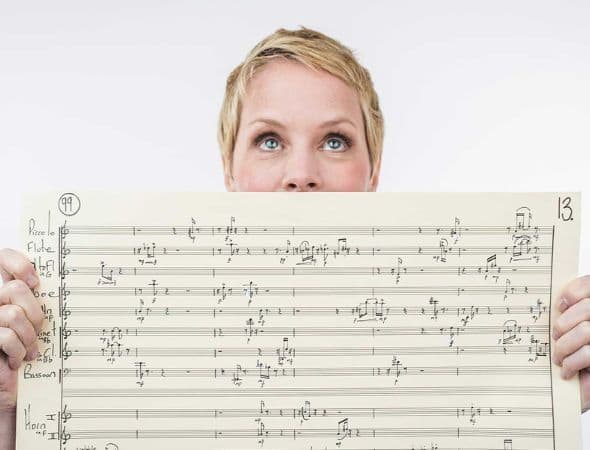AUGUSTA READ THOMAS: Dance Foldings
In celebration of the diversity and the mission statement of the Royal Albert Hall on the occasion of the venue’s 150th anniversary, the BBC Radio 3 commissioned Dance Foldings for orchestra for which the commission prompt was to reflect the arts and sciences as they are now. Composers were free to choose their own subject, so long as there was a clear link to the sciences or to other art forms.
The natural world, as explored by scientists, engineers, and physicians in their laboratories and clinics, offers a wealth of opportunities to explore resonance and balance through sound. Few orchestral works attempt to capture the kinetic and emotional content of scientific topics and convey these concepts through abstract, rather than descriptive, music.
The musical materials of Dance Foldings for orchestra take as their starting point the metaphors, pairings, counterpoints, foldings, forms, and images inspired by the biological “ballet” of proteins being assembled and folded in our bodies. Online, one can easily find many beautiful animations which show the process of protein folding. Some resemble assembly lines, and many look like ballets; both are extremely suggestive of musical possibilities. For example, proteins are made in cells by linking together amino acids one at a time to make a linear chain, i.e., the primary structure, or unfolded protein, which is akin to a wiggling chain of beads. These chains take musical form as animated, rhythmic, and forward-moving lines of music which unfold with kaleidoscopic sonic variety. An amino acid chain gradually self-organizes into nicely lined up shorter strands of beads forming pleated sheets or helices, nestled next to each other; interconnecting strands form loops crossing over in three dimensions. Musically speaking, those three-dimensional forms are affiliated to counterpoint, harmony, flow, flux, and form. Notated on the score are indications including: “Like Chains of Amino Acids”, “An Amino Acid Chain starting to fold and become a protein”, “Brass Protein Foldings #1, Like jazz big band meets Stravinsky”, and “Another Amino Acid Chain-making Machine”.

Photo: Anthony Barlich
Protein folding is essential to life, and form dictates function. Proteins have primary, secondary, tertiary, and quaternary structures, and this make-up naturally falls into manifold musical possibilities with distinctive materials, sonorities, rhythms, counterpoint, and inner-life.
No matter what the external inspiration, music must work as music. As such, I create music that is organic and, at every level, concerned with transformations and connections, which should be played so that the interconnectivity of the different rhythmic, timbral and pitch syntaxes are made explicit and are then organically allied to one another with characterized phrasing of rhythm, color, harmony, counterpoint, tempo, breath, keeping it alive—continuously sounding spontaneous. All of this, hopefully, working toward the fundamental goal: to compose a work in which every musical parameter is nuanced and allied in one holistic gestalt.
If I listen carefully, the piece I am composing has its own inner life and will tell me what it next needs. The music I create is passionate, involving risk and adventure, such that a given musical moment might seem like a surprise right when you hear it but, only a millisecond later, seems inevitable. One of my main artistic credos has been to examine small musical objects–a chord, a motive, a rhythm, a color, an energy field, a harmonic space–and explore them from every possible perspective. The different perspectives reveal new musical elements, which I then transform and which in turn become the musical development.
Although highly notated, precise, carefully structured, soundly proportioned, and while musicians are elegantly working from a nuanced, specific text, I like my music to have the feeling that it is organically being self-propelled, on the spot. As if we listeners are overhearing a captured improvisation.
Dance Foldings is an example of the many synergies between science (nature) and music. I previously composed Helix Spirals for string quartet to commemorate the Meselson-Stahl DNA replication discovery of 1958. Since DNA is the blueprint for making the proteins of any organism, protein construction, folding and animation is a natural next project.
Commissioned by BBC Radio 3 and first performed by BBC National Orchestra of Wales conducted by Ryan Bancroft on August 8, 2021 at the Royal Albert Hall as part of BBC Proms 2021. Dedicated with admiration and gratitude to BBC National Orchestra of Wales, Ryan Bancroft and Lisa Tregale and to The Boston Symphony Orchestra, Andris Nelsons and Anthony Fogg. Special thanks to the Sounds of Science Commissioning Club for contributing support to this project. The US Premiere was given by the Boston Symphony Orchestra, Andris Nelsons, conducting in Boston Symphony Hall on January 13, 14, 15, 16 2022. Augusta sends special thanks to Andris Nelsons and to Anthony Fogg.











